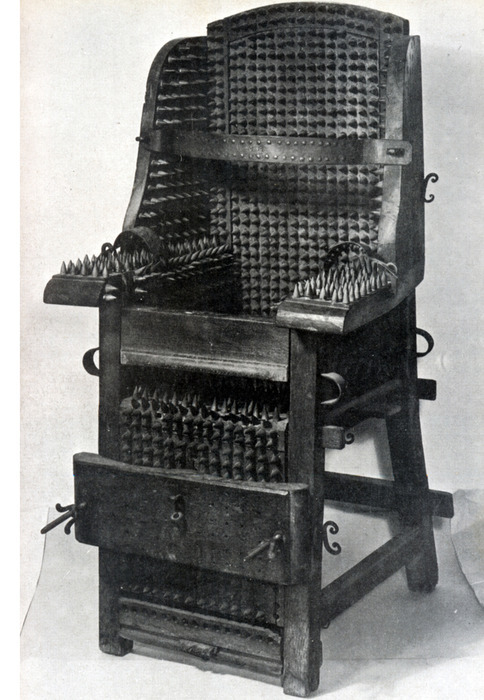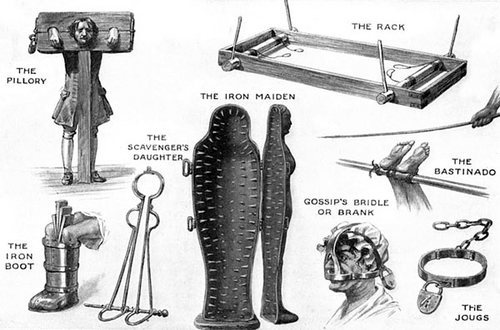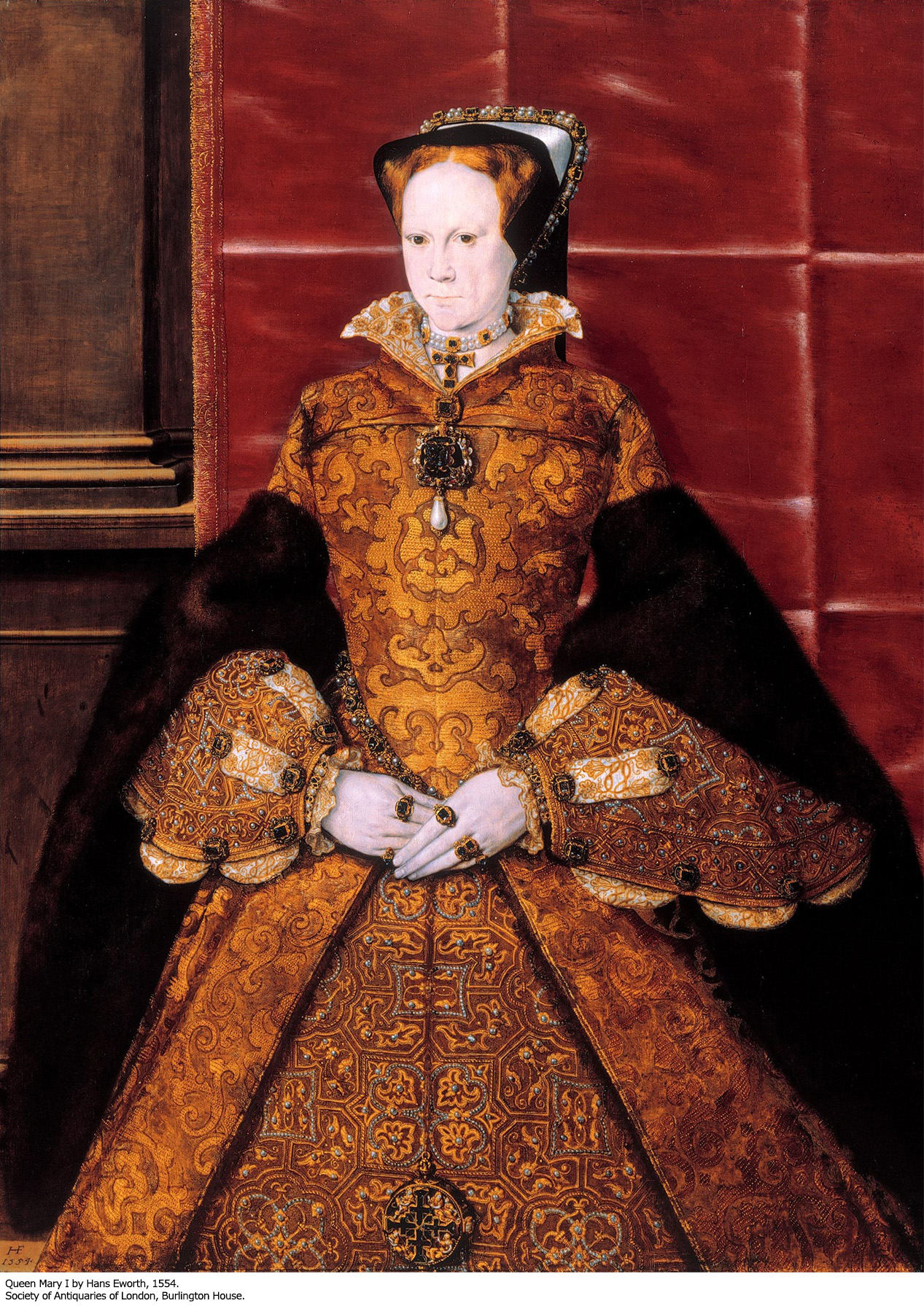-
IP addresses are NOT logged in this forum so there's no point asking. Please note that this forum is full of homophobes, racists, lunatics, schizophrenics & absolute nut jobs with a smattering of geniuses, Chinese chauvinists, Moderate Muslims and last but not least a couple of "know-it-alls" constantly sprouting their dubious wisdom. If you believe that content generated by unsavory characters might cause you offense PLEASE LEAVE NOW! Sammyboy Admin and Staff are not responsible for your hurt feelings should you choose to read any of the content here. The OTHER forum is HERE so please stop asking.
You are using an out of date browser. It may not display this or other websites correctly.
You should upgrade or use an alternative browser.
You should upgrade or use an alternative browser.
The Horror Holy Medieval Inquisition -50 million tortured and killed!
The Medieval Inquisition was in response to large popular movements throughout Europe considered apostate or heretical to Christianity, in particular Catharism and Waldensians in southern France and northern Italy. These were the first inquisition movements of many that would follow.

Investigation
When a papal inquisition arrived at a town it had a set of procedures and rules to identify likely heretics. First, the townspeople would be gathered in a public place. Although attendance was voluntary, those who failed to show would automatically be suspect, so most would come. The inquisitors would provide an opportunity for anyone to step forward and denounce themselves in exchange for easy punishment. As part of this bargain they would need to inform on other heretics. In addition, the inquisitors could simply force people to be interrogated. Once information had been gathered, an inquisitorial trial could begin
Last edited:
Trial
The inquisitorial trial generally favored the prosecution (the Church). Confessing 'in full' was the best hope of receiving a lighter punishment - but with little hope of escaping at least some punishment. And a 'full' confession was one which implicated others, including other family members. It was acceptable to take testimony from criminals, persons of bad reputation, excommunicated people, and convicted heretics. The inquisitor could keep a defendant in prison for years before the trial to obtain new information, and could return them to prison if he felt that the witness had not fully confessed.
Despite the unfairness of the procedures, the inquisitors did provide some rights to the defendant. At the beginning of the trial, defendants were invited to name those who had "mortal hatred" against them. If the accusers were among those named, the defendant was set free and the charges dismissed; the accusers would face life imprisonment. This option was meant to keep the inquisition from becoming involved in local grudges. Early legal consultations on conducting inquisition stress that it is better that the guilty go free than that the innocent be punished; though in practice, inquisitors had quite a wide sense of what constituted guilt, making innocence a rare commodity.
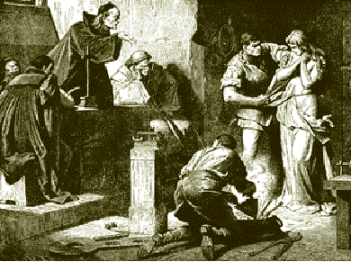
Torture
Torture could be used after 1252. On May 15, Pope Innocent IV issued a papal bull entitled Ad exstirpanda, which authorized the use of torture by inquisitors. Torture was undoubtedly used in the trial of the Templars, but is in fact not much found in heresy trials until the later fourteenth century. Torture methods that resulted in bloodshed, births, mutilation or death were forbidden. Also, torture could be performed only once. However, it was common practice to consider a second torture session to be a "continuation" of the first. Torture methods included hanging by the wrists, with weights suspended from the ankles (a form of torture known as strappado), the rack, and waterboarding.
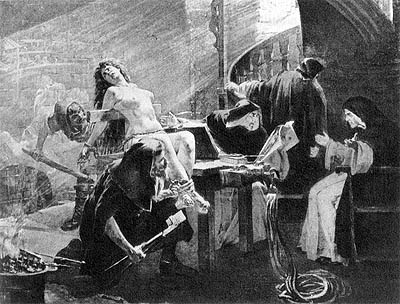
Punishment
Among the possible punishments were prayer, pilgrimage, wearing a yellow cross for life, banishment, public recantation, or, occasionally, long-term imprisonment. The unrepentant and apostates could be "relaxed" to secular authority, however, opening the convicted to the possibility of various corporal punishments, up to and including being burned at the stake. Execution was neither performed by the Church, nor was it a sentence available to the officials involved in the inquisition, who, as clerics, were forbidden to kill. The accused also faced the possibility that his or her property might be confiscated. In some cases, accusers may have been motivated by a desire to take the property of the accused, though this is a difficult assertion to prove in the majority of areas where the inquisition was active, as the inquisition had several layers of oversight built into its framework in a specific attempt to limit prosecutorial misconduct.
The inquisitors generally preferred not to hand over heretics to the secular arm for execution if they could persuade the heretic to repent: Ecclesia non novit sanguinem. For example, Bernard Gui, a famous inquisitor working in the area of Carcassonne (in modern France), executed 42 people out of over 900 guilty verdicts in fifteen years of office. Execution was to admit defeat, that the Church was unable to save a soul from imagined heresy, which was the goal of the inquisition.
Last edited:
I note with curiosity that those being inquired we're in diff state of undress...that's origin of bdsm as we know today ?
Why was Queen Mary Tudor known as Bloody Mary?
The eldest daughter of King Henry VIII and Queen Catherine of Aragon reigned as Queen Mary of England from 1553 to 1558. Just five years. How, in such a short period of time, was this woman, the rightful heir to the English throne, given the terrible nickname of Bloody Mary?
Her nickname - Bloody Mary - came from the number of Protestant Tudors who were executed during her reign. The nickname, Bloody Mary, was not given to Mary Tudor until after her death. It was given to her for the religious genocide of men of the Protestant faith during her reign. A nickname such as 'Bloody Mary' would indicate that she had been the cause of thousands of deaths. In fact only 287 Protestant executions during her reign. In comparison her father, King Henry VIII, had been responsible for 57,000 deaths including men such as Sir Thomas More. So why was Queen Mary Tudor known as Bloody Mary?
The method of execution of many of the Protestants was execution by burning. This was the favored execution method of the Catholic Spanish Inquisition. Mary Tudor married King Phillip II of Spain. The English people were terrified that the Inquisition would be introduced into England. After her death England returned to the Protestant religion under Queen Elizabeth I. The reign of Queen Elizabeth I also saw the attempted invasion by the Spanish Armada. Under these circumstances the name of the Catholic Mary Tudor, wife of the hated Spanish King, was totally blackened. Queen Mary Tudor was given the name 'Bloody Mary'. And this is how she is still referred to in England.
The eldest daughter of King Henry VIII and Queen Catherine of Aragon reigned as Queen Mary of England from 1553 to 1558. Just five years. How, in such a short period of time, was this woman, the rightful heir to the English throne, given the terrible nickname of Bloody Mary?
Her nickname - Bloody Mary - came from the number of Protestant Tudors who were executed during her reign. The nickname, Bloody Mary, was not given to Mary Tudor until after her death. It was given to her for the religious genocide of men of the Protestant faith during her reign. A nickname such as 'Bloody Mary' would indicate that she had been the cause of thousands of deaths. In fact only 287 Protestant executions during her reign. In comparison her father, King Henry VIII, had been responsible for 57,000 deaths including men such as Sir Thomas More. So why was Queen Mary Tudor known as Bloody Mary?
The method of execution of many of the Protestants was execution by burning. This was the favored execution method of the Catholic Spanish Inquisition. Mary Tudor married King Phillip II of Spain. The English people were terrified that the Inquisition would be introduced into England. After her death England returned to the Protestant religion under Queen Elizabeth I. The reign of Queen Elizabeth I also saw the attempted invasion by the Spanish Armada. Under these circumstances the name of the Catholic Mary Tudor, wife of the hated Spanish King, was totally blackened. Queen Mary Tudor was given the name 'Bloody Mary'. And this is how she is still referred to in England.
thanks. learnt abit about Catharism and the albigensian crusade today.
http://en.wikipedia.org/wiki/Albigensian_Crusade
http://en.wikipedia.org/wiki/Albigensian_Crusade
Similar threads
- Replies
- 1
- Views
- 337
- Replies
- 0
- Views
- 196
- Replies
- 1
- Views
- 154
- Replies
- 1
- Views
- 400

